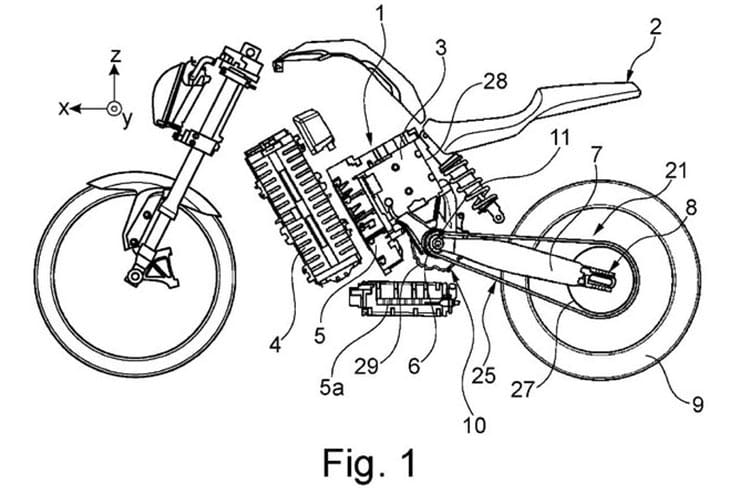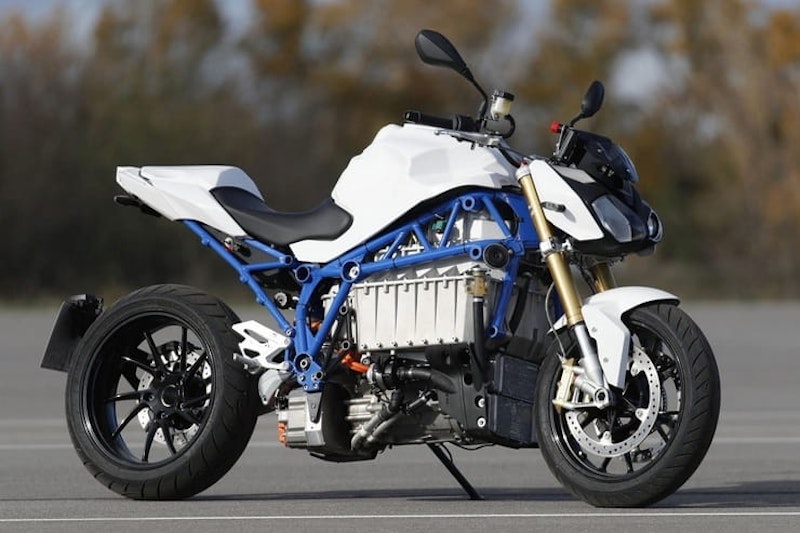BMW’s electric G 310 R project gathers pace
By Ben Purvis
Motorcycle Journalist
20.03.2023
BMW has been a leading light in the electric two-wheeler movement with nearly a decade of production under its belt for the C Evolution scooter and now the CE 04 that superseded it but despite plenty of concepts and show bikes the company has yet to productionise an electric motorcycle to go with its battery-powered scooter. That looks set to change soon and the first electric BMW motorcycle could be a city-oriented machine that shares parts with the CE 04 – as illustrated in this new patent application.
BMW’s electric concept bikes have been towards the upper end of the market, with models like the Vision DC Roadster and Vision Next 100 showing how a future EV two-wheeler could replicate the ‘boxer’ look that’s synonymous with the brand. Meanwhile, the firm’s running E-Power Roadster prototype is a hefty beast using various components harvested from the R-series twins and hampered by heavy, bulky batteries and a motor from the firm’s car division.
The E-Power Roadster prototype was big and heavy, used car components
While the idea of a high-performance, long-range electric bike might be tempting, and something of a holy grail for motorcycle makers, real-world examples are vanishingly rare. Although the likes of Zero and Energica have shown that EV bikes can compete with middleweight combustion-engine models, albeit at a price, limitations on range and charging speed remain big hurdles when it comes to persuading buyers.
At the shorter-range, lower-performance end of the market, that task isn’t so tough. Lower prices mean customers recoup their investment in fuel savings faster, and at city speeds the instant torque and ease of use of electric bikes allied to their near-silence and zero-emissions powertrains make an increasingly compelling argument for the technology. It’s not by accident that BMW’s first ten years of electric two-wheelers have focussed on scooters, and rivals are largely following the same route. The next logical step is to use similar technology and performance in a motorcycle package – which is what you see in this new patent from BMW.
Vision DC Roadster was shown four years ago but doesn’t seem any nearer production
The bike illustrated in the patent is clearly a similar size to the G310 range, with overtones of the G310R in its shape, but a large front wheel like the G310GS. However, those parts aren’t important – the clever bit is the layout, which appears to recycle components from the CE 04 into a more compact, motorcycle-shaped package.
All the major elements – the batteries, the control electronics and the motor – look to be borrowed from the CE 04. With a peak of 42hp, the CE 04 has 8hp more than the G310 singles but more than double their torque at 46 lb-ft, enough to offset the extra mass of the electric powertrain when it comes to acceleration.
To fit the parts into the much shorter wheelbase of the G310 (1380mm vs a vast 1685mm for the CE -04), the parts are cleverly rearranged.
Most importantly, the motor is turned 90-degrees so its shaft runs longitudinally rather than across the bike. It’s also tilted up at around a 45-degree angle, making a shorter, taller package. It drives a bevel gear that takes power to the front sprocket while also acting as a reduction gearbox to multiply torque and gear down the motor’s rotational speed. A belt final drive and large rear sprocket adds another layer of reduction.
Tilted, longitudinal layout in new patent allows big motor in a small space
Like the motor, the battery pack appears to be borrowed from the CE 04 but gets tilted at a steep angle to again make a much shorter, taller package. As well as allowing a far shorter, wieldier wheelbase, it’s a solution that raises the centre of gravity, which should further enhance the motorcycle-style handling over the stability-focussed design of the scooter.
The electronic control units and charger also look to be the same as the ones on the CE 04, but repositioned again, with one box of electronics shifted into the bike’s belly. The design doesn’t compromise storage space, either, as the ‘tank’ area remains clear of components, allowing a space that should be large enough to accept a helmet.
By reusing parts from the CE 04, BMW should be able to benefit from economies of scale to keep costs down, although even with G310-style performance a battery-powered BMW bike is likely to be substantially more expensive than an ICE one. For an idea, the CE 04’s prices start at £12,850.
BMW has already nabbed a range of trademarks for future electric motorcycles, using the letters ‘DC’ followed by a number that represents the performance level. In the future, there will be a ‘CE’ scooter range (the CE 02 concept scooter is believed to be heading for production next to sit alongside the larger CE 04), and a ‘DC’ motorcycle line up. Given the shared CE 04 components and a power level roughly equivalent to a 400cc machine, the bike in this new patent could become the ‘DC 04’.
Share on social media:

